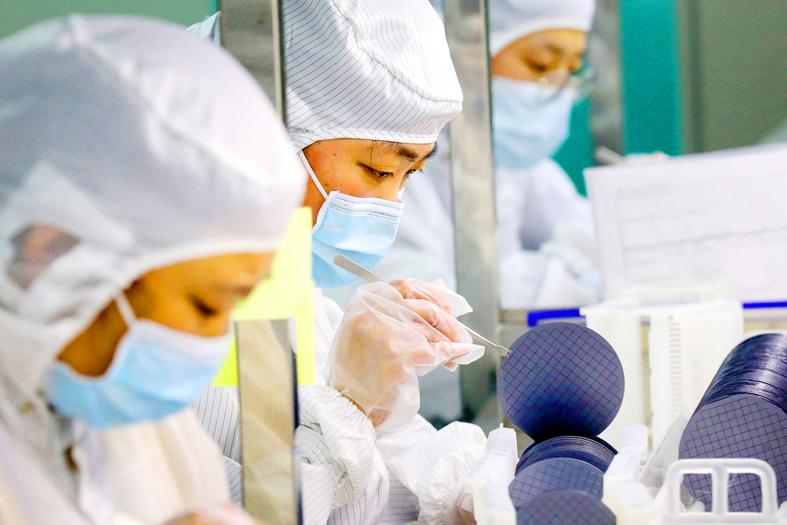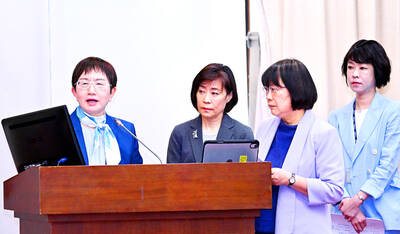Semiconductor Manufacturing International Corp (SMIC, 中芯國際) is to build a US$2.35 billion plant with funding from the Shenzhen City Government, the first major project to emerge from China’s master plan to match the US and become more self-reliant amid a global chip shortage.
SMIC yesterday said that shortages could worsen this year and next, harming Chinese businesses if the country does not immediately increase domestic capacity.
In the joint venture with Shenzhen, the company has agreed to develop and operate a manufacturing facility that can produce chips using 28-nanometer technology, it said in a stock exchange filing.

Photo: AFP
The partners aim to attract third-party investment, begin production by next year and eventually produce 40,000 12-inch wafers per month.
“The shortage in chip manufacturing capacity is very real, and the situation could deteriorate in 2021 and 2022 if Chinese companies don’t speed up expansion,” SMIC senior vice president Zhang Xin (張昕) told the SEMICON China conference in Shanghai.
Beijing is moving swiftly to cut a dependence on the West for crucial components such as chips, an issue that became more urgent after a global shortage of semiconductors worsened during the COVID-19 pandemic.
Washington has also blacklisted major Chinese tech firms, including SMIC, cutting it off from US technology, while severely impairing its ability to procure the equipment it needs to make chips.
It remains unclear whether US President Joe Biden’s administration might allow US firms to resume selling to SMIC on a large scale, or ease up on pressuring allies in Europe and elsewhere to boycott the Chinese company.
Mergers with the government might prove essential to achieving the country’s ambitions. Chinese chipmakers aim to progress past the more mature 28-nanometer nodes — now used in industries from automaking to TVs — but need billions of dollars and years of research to produce more sophisticated semiconductors for gadgets such as smartphones.
Much of China’s hopes rest on making headway in burgeoning fields such as artificial intelligence and third-generation chips: Mainly made of materials such as silicon carbide and gallium nitride, they can operate at high frequency and in higher power and temperature environments, with broad applications in 5G, military-grade radar and electric vehicles.
SMIC’s Shenzhen project would mark one of the few plants in the country focused on larger 12-inch rather than 8-inch wafers, which save on cost because more chips can be sliced from it, but are far more difficult to fabricate.
SMIC operates fabs in four cities, including Beijing and Shanghai. It would own 55 percent of the planned factory, with a government-owned entity owning up to a 23 percent stake.
“Silicon wafer is a fundamental raw material in semiconductor manufacturing, yet it is also one of the areas in China’s semiconductor supply chain that has the lowest level of local production, especially 12-inch silicon wafers,” Li Wei (李煒), executive vice president of the National Silicon Industry Group (矽產業集團), a state-backed wafer manufacturer, told the conference on Wednesday.

‘SWASTICAR’: Tesla CEO Elon Musk’s close association with Donald Trump has prompted opponents to brand him a ‘Nazi’ and resulted in a dramatic drop in sales Demonstrators descended on Tesla Inc dealerships across the US, and in Europe and Canada on Saturday to protest company chief Elon Musk, who has amassed extraordinary power as a top adviser to US President Donald Trump. Waving signs with messages such as “Musk is stealing our money” and “Reclaim our country,” the protests largely took place peacefully following fiery episodes of vandalism on Tesla vehicles, dealerships and other facilities in recent weeks that US officials have denounced as terrorism. Hundreds rallied on Saturday outside the Tesla dealership in Manhattan. Some blasted Musk, the world’s richest man, while others demanded the shuttering of his

Taiwan’s official purchasing managers’ index (PMI) last month rose 0.2 percentage points to 54.2, in a second consecutive month of expansion, thanks to front-loading demand intended to avoid potential US tariff hikes, the Chung-Hua Institution for Economic Research (CIER, 中華經濟研究院) said yesterday. While short-term demand appeared robust, uncertainties rose due to US President Donald Trump’s unpredictable trade policy, CIER president Lien Hsien-ming (連賢明) told a news conference in Taipei. Taiwan’s economy this year would be characterized by high-level fluctuations and the volatility would be wilder than most expect, Lien said Demand for electronics, particularly semiconductors, continues to benefit from US technology giants’ effort

ADVERSARIES: The new list includes 11 entities in China and one in Taiwan, which is a local branch of Chinese cloud computing firm Inspur Group The US added dozens of entities to a trade blacklist on Tuesday, the US Department of Commerce said, in part to disrupt Beijing’s artificial intelligence (AI) and advanced computing capabilities. The action affects 80 entities from countries including China, the United Arab Emirates and Iran, with the commerce department citing their “activities contrary to US national security and foreign policy.” Those added to the “entity list” are restricted from obtaining US items and technologies without government authorization. “We will not allow adversaries to exploit American technology to bolster their own militaries and threaten American lives,” US Secretary of Commerce Howard Lutnick said. The entities

Minister of Finance Chuang Tsui-yun (莊翠雲) yesterday told lawmakers that she “would not speculate,” but a “response plan” has been prepared in case Taiwan is targeted by US President Donald Trump’s reciprocal tariffs, which are to be announced on Wednesday next week. The Trump administration, including US Secretary of the Treasury Scott Bessent, has said that much of the proposed reciprocal tariffs would focus on the 15 countries that have the highest trade surpluses with the US. Bessent has referred to those countries as the “dirty 15,” but has not named them. Last year, Taiwan’s US$73.9 billion trade surplus with the US